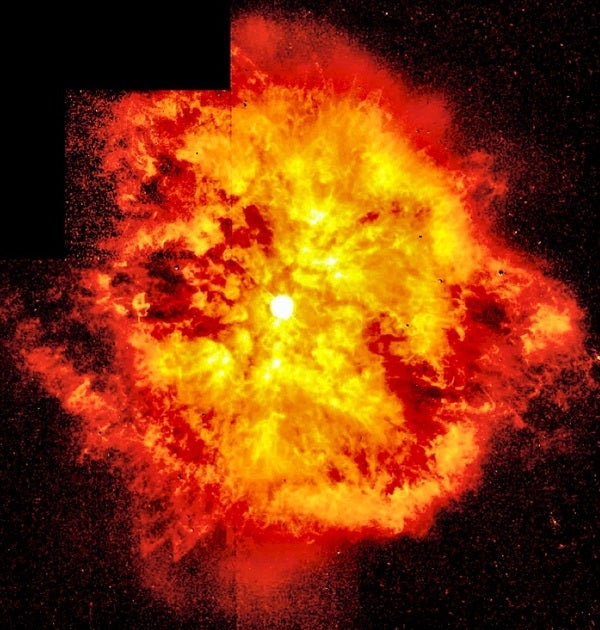WR stars have typical masses around 20 times greater than the Sun’s and probably represent the last stage in the evolution of massive O-type stars. WR stars likely end their lives as either type Ib or Ic supernovae, which also are associated with gamma-ray bursts. Long before these stars explode, they leave their imprint on the interstellar medium. Their high surface temperatures (50,000 kelvins and up) and luminosities (100,000 suns and greater) drive stellar winds as fast as 1,500 miles (2,500 kilometers) per second. Such winds remove up to two-thirds of the star’s original mass and, throughout the lifetime of the WR phase, release kinetic energy comparable to the amount produced by the supernova explosion that follows. Some WR stars occur in binary star systems, so in these cases, transfer to a close stellar companion may help them lose mass, too.
The most distinguishing characteristic of a WR star is its spectrum. In 1867, this is what caught the eyes of French astronomers Charles Wolf and Georges Rayet, who first described these peculiar stars while using a visual spectroscope at the Paris Observatory. Hydrogen is absent in nearly all WR spectra because stellar winds have stripped the stars of their hydrogen envelopes. What’s left is essentially a bare stellar core, rich with helium, carbon, and other products of advanced nuclear burning. Because these elements also are being blown off by stellar winds, WR stars enrich the space around them with heavier elements.
Observers in the Southern Hemisphere and at low northern latitudes easily can see one WR star with the naked eye: Gamma2 (γ2) Velorum. Part of a well-known multiple star system, Gamma2 Velorum shines at magnitude 1.8 in the constellation Vela and lies about 840 light-years away. This star is really two: a WR star and its brighter type O companion. The two wheel about one another every 78.5 days. Separated only by about the distance between Earth and the Sun, the two cannot be resolved as individual stars in a telescope.
The brightest WR star visible to everyone in the Northern Hemisphere is 6.7-magnitude HD 190918, also known as SAO 69402 and numbered 133 in the catalog of known Milky Way WR stars. WR 133, which also has an O-type companion star, is associated with NGC 6871, a young open star cluster located near the center of the “cross” in Cygnus.
— FRANCIS REDDY, ASSOCIATE EDITOR










